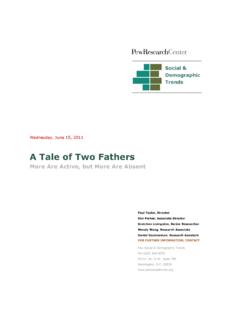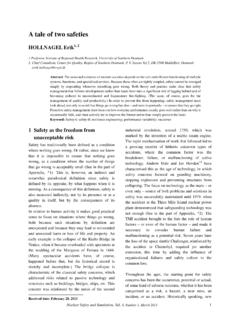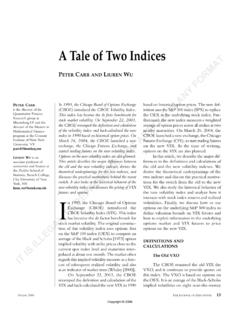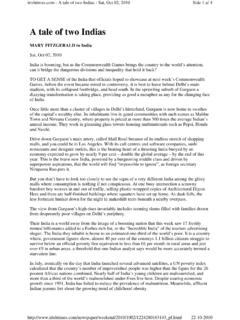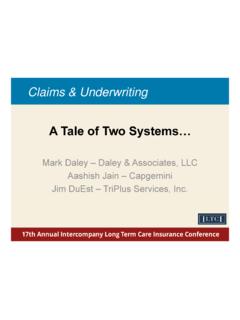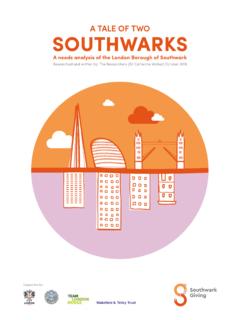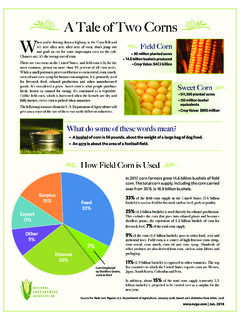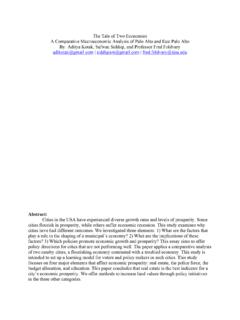Transcription of A Tale of Two Handouts: Applying Health Literacy ...
1 a tale of two handouts : Applying Health Literacy recommendations to Improve readability of Printed Patient Education Materials By Doug Seubert Project Coordinator, Primary Prevention Pilot H ealthy People 20101 defines Health Literacy as the degree to which individuals have the capacity to obtain, process, and understand basic on the quality and accessibility of these materi- als. An electronic survey was sent to 73 primary care departments within the Marshfield Clinic sys- Health information and services needed to make tem. Department managers were asked to distribute appropriate Health decisions. This definition is the a link to the survey Website to all staff who have cornerstone of the Primary Prevention Pilot, a Healthy direct contact with patients, as well as those involved in Lifestyles Special Project at Marshfield Clinic. The ordering education materials used with patients during focus of the project is to develop printed education office visits.
2 Surveys were completed by physicians, materials promoting healthy lifestyle changes to help advance practice providers (Physician Assistants, prevent hypertension, dyslipidemia, diabetes and obe- Nurse Practitioners, etc.), Registered Nurses, medical sity in children and adults. assistants, and other staff. See Table 1 for total surveys returned in each of these categories. The project includes an assessment and evaluation of the education materials currently in use at Marshfield A series of introductory statements on the survey Clinic, as well as identifying the need for new edu- were designed to gauge Health care providers' per- cational handouts on healthy lifestyles and primary ceptions regarding the accessibility and readability prevention topics. Another main component of the of available patient education materials. One state- project is the development of a toolbox of resources, ment in particular asked survey participants their including recommendations for Health Literacy and opinion regarding the reading level of printed patient templates for improving the readability of printed education materials currently in use at Marshfield patient education materials.
3 Clinic. Participants were asked to agree or disagree with this statement: Primary prevention education A Collaborative Approach materials available through the Marshfield Clinic online patient education catalog are written at an The Primary Prevention Pilot is a collaborative appropriate reading level for most patients. The approach to prevention education. Several depart- results, listed in Table 1, showed that as a group, 59%. ments are working together to improve the printed agreed to the statement, 20% disagreed, and another materials given to patients at Marshfield Clinic. The 21% indicated they were not able to form an opinion project involves over 40 physicians and other medical regarding reading level of patient education materials. and non-medical staff from Quality Improvement and Care Management, Patient Education and Nutrition The physician group showed 54% agreed with the Services, the Healthy Lifestyles Program, the Center statement, while only 7% disagreed.
4 For Registered for Community Outreach, Occupational Health , Nurses 58% agreed to the statement, but 28% (4 times Work/Life, ProActive Health , Family Health Center, as many in the physician group) had the opinion that and Security Health Plan. printed education materials used at Marshfield Clinic are not written at an appropriate reading level for Assessing Perceptions and Printed Words most patients. While the medical assistant group had The project began with an assessment to determine the least number of returned surveys, 100% of those which prevention education materials were used most responding agreed that printed education materials often with patients, and to collect general feedback are written at an appropriate reading level. Table 1: Survey Totals and Perception of Reading Level Primary prevention education materials available through the Marshfield Clinic online patient education catalog are written at an Number of appropriate reading level for most patients.
5 Returned Surveys Agree Disagree Not Sure All Categories Combined 138 59% 20% 21%. Physicians and Advanced Practice Providers 46 54% 7% 39%. Registered Nurses 45 58% 28% 14%. Medical Assistants 15 100% 0% 0%. Other 27 56% 26% 18%. The difference of opinion among survey responders in patient education materials should be written at a read- their respective groups is interesting in and of itself; ing level between sixth and eighth grade. While our but, it is the second part of the assessment that provides survey did not ask Health care providers to determine the key to understanding how readability is perceived the reading grade level of the printed materials they use among Health care providers. with their patients, we assume that most would agree that materials should be written at a level that increases Most Health care materials are written at a 10th-grade readability , comprehension and compliance among the level or However, most adults read between majority of patients.
6 There will be special populations the eighth and ninth grade level, with 21 to 23 percent and unique patients that require additional assistance of adults reading at the lowest reading level, approxi- regarding patient education, but the standard should be mately fifth-grade or The problem of inadequate to produce written education materials that meet the Literacy is greater in older patients. The majority of Health Literacy needs for the majority of patients. patients older than 60 years perform at the lowest lev- els of For patients whose primary language is Our assessment continued by evaluating a sampling not English, the problem is A survey of of the printed patient education materials currently patients at two hospitals revealed that 35 percent of being used with patients at Marshfield Clinic. In keeping English-speaking patients and 62 percent of Spanish- with the focus of our project, we only evaluated patient speaking patients had fair to poor Health education sheets on healthy lifestyles and primary pre- vention topics.
7 We also excluded printed education Knowing these facts, the simple conclusion is that printed materials purchased from vendors outside of Marshfield Table 2: Assessment of SMOG Grade Levels SMOG. Grade Level Titles of Existing Patient Education Materials How Much Are You Eating Lifestyle Modifications to Manage Hypertension Healthy Brown Bag Lunches Body Mass Index (BMI). Cholesterol Management Eating and Exercising for Heart Health Your Cholesterol Numbers Controlling Your Risk Factors for a Heart Attack Low-Cholesterol/Low-Fat Diet Food List Triglycerides Tips to Reduce Cholesterol/Saturated Fat Intake Dining Out the Healthy Way Average SMOG Grade Level 2. Clinic and those printed from copyright-free or public when applied to existing patient education handouts , domain Web sites such as the National Institutes of Health effectively lowered the reading grade levels of the and the Center for Disease Control and Prevention. printed materials.
8 The list of recommendations used is Our focus was on printed patient education materials displayed in Figure 1. written and produced by Health care providers within Marshfield Clinic. Figure 1: Health Literacy recommendations Checklist Reading grade levels for 11 patient education handouts Content/Style were calculated using the following SMOG7 formula: The material is interactive and allows for audience involvement, using devices to engage the reader . number of polysyllables X ( number of sentences ) + 30 such as Q & A, true-or-false, problem-solution, stories, dialogues, and vignettes. A conversational style is used whenever appropriate that includes the patient and improves readability . The SMOG readability formula was chosen over the One- or two-syllable words are used and all Flesch-Kincaid Grade Level formula because it uses a unnecessary multi-syllable words are replaced with more precise formula to calculate a high ( ) correla- simpler words.
9 Tion with the grades of readers who had 100% compre- Technical and medical terms are defined clearly, and hension of test materials. Also, Literacy specialists warn only used when necessary. that Flesch-Kincaid scores tend to underestimate actual Content is limited to what patients really need to know. reading grade level because they are often several grade How to advice is offered, urging behavior that is levels below results obtained using other feasible and culturally appropriate for the intended The results of our evaluation showed an average SMOG audience. grade level of for the sample patient education The material tells the reader how and where to get handouts , with the highest scoring a grade level of help or more information. and the lowest a grade level of See table 2. Layout Type style and size of print are easy-to-read; type is at least 12 point. Our assessment supports the finding that most Health The document uses an effective combination of care materials are written at a 10th-grade level or higher.
10 Readable type styles to get good contrast between the Because the average reading grade level was (three text and the headings and titles. to five grade levels higher than what is recommended), Labels for sections, headings, and subheadings are it also supports the finding that many Health care clear and informative to the intended audience. Lines of text are an appropriate length for easy providers misjudge the reading grade level of the educa- reading (no more than about five inches, set in tion materials they often use with patients. As noted in columns). Table 1, only 7% of physicians and advanced practice Layout balances white space with words and providers, and 28% of Registered Nurses participating illustrations. in our survey recognized the patient education materials Visuals scored in Table 2 as not being written at an appropriate Visuals are relevant to text, meaningful to the reading level for most patients. Another 39% of phy- audience, and appropriately located.

